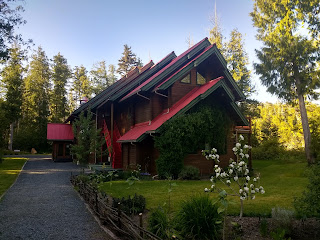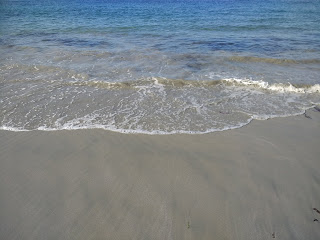May 12 (Day 15):
Our voyage from Port Hardy to Allison Harbour on the mainland provided a good, full day of sailing. We expected high winds out of the northeast and found them. With winds from 15-25 knots and gusts from 25-28, we reefed both the main and jib on a close haul. Fortunately, we could fall off the wind after rounding the Walker and Deserters Island group, and we had Allison Harbour in our sight.
Allison Harbour provides a welcome respite to the weary sailor. Tucked behind a bluff that blends seamlessly into the surrounding shoreline, a narrow passageway opens to a long, open, and most importantly, calm inlet. It’s a favored spot for cruising boats to wait out the weather around Cape Caution, and without our charts, we wouldn't have known it was there.
The waves crashed nearly vertical against the entrance, and we aggressively dodged every submerged rock and floating log as we managed to furl in our jib and flake pull down our mainsail. Once over the threshold to the inlet, things got easy again, and we tucked in behind the other four boats in the head of the bay for the night.
From a mariner’s point of view, the most significant landmarks are called “capes.” Horn, Good Hope, Cod, Hatteras…the list is well known. Cape Caution marks the most significant passage on the British Columbia coast; rounding it is a nautical coming of age…Serious cruisers who [cross it] enter a fraternity of mutual respect where they experience the space, the solitude, and the silence of one of the world’s wildest coastlines.
–Roderick Frazier Nash
Cape Caution is the first open ocean exposure on the Inside Passage, so it carries a tremendous amount of power and respect from northbound first-timers (like us). Even the name evokes trepidation and second thought.
We chose today to cross because the weather report promised the calmest conditions. 10-15 knots from the northwest with swells of 2 meters seemed perfect for our first cape crossing, at least when compared to the forecast for other days. But Environment Canada was clearly mistaken, as it often is.
The fog rolled in early in the morning and stayed there, shrouding the inlet in a thick mist. But we timed our departure at 8am so we would pass Slingsby Channel at slack tide.
Just south of the cape, Slingsby Channel provides the outflow of Nakwakto Rapids, and sailing past it at the wrong time can seriously churn up the sea. Big westerly swell with an ebb current from this channel results in big, steep seas and queasy crew, so we wanted to avoid that!
Just south of the cape, Slingsby Channel provides the outflow of Nakwakto Rapids, and sailing past it at the wrong time can seriously churn up the sea. Big westerly swell with an ebb current from this channel results in big, steep seas and queasy crew, so we wanted to avoid that!
 |
| Fog outside of Allison Harbour |
Still enveloped in fog, we motored through South Passage, avoiding the infamous offshore rock field. There was very little wind, much less than we hoped. Every breeze we felt, we’d turn off the engine and attempt to sail. With the seas higher in feet than the wind in knots, our sails would luff and we’d stand still. After several minutes of false and foolish hope, we’d give up and turn on the engine again. We followed this routine many times as the hours pressed on.
I’m sure the cape was beautiful. I’m sure, had we been able to see it in the distance, we would have celebrated the momentous occasion with a toast. But to us, motoring around a cape didn’t hold the same romance or awe as hoisting the sails and harnessing the winds around it. So we simply shrugged and motored on.
But then we crossed the northern tip of the cape and reached Rivers Inlet. Wind rolled in and the fog lifted, revealing a landscape more gorgeous than we imagined. Here it was. All of Northern BC unraveled before us in its glory—snowcap peaks, boundless untouched forests, and white sand beaches. We had arrived.
And all the romance and awe we lost in the fog came rushing back. The fact that we motored instead of sailed around the cape no longer mattered. We made it. We arrived, and after years of preparation, hard work, and learning, we now get to explore one of the most beautiful and remote areas of the world.
For the last two hours of the passage, we downwind sailed in some of the best conditions we’d seen on the trip. A steady 15 knots and flat seas led us up to the entrance of our anchorage in Fury Cove (Penrose Island) where we tucked in among several other boats who had made the same journey. Together, we reveled in our “fraternity of mutual respect [to] experience the space, the solitude, and the silence of one of the world’s wildest coastlines.”
On a separate note, Happy Mothers’ Day to Nancy and Ellen. Thank you for instilling in us a sense of truth and a respect for nature and thank you for supporting our dreams, however crazy they may be. J
 |
| Great sailing in Rivers Inlet |
 |
| Great sailing in Rivers Inlet |
 |
| We made it! |
 |
| Tucked into Fury Cove |
May 14 (Day 17):
My god, Fury Cove is spectacular. Its white sandy beaches and emerald waters seem almost tropical. The 70+ degree weather (21+ Celsius) doesn’t hurt either.
There seems to be a shared camaraderie among the boaters here. While most boaters generally keep to themselves further south, cruisers here may slow their dinghies when passing an anchored boat, ready to share stories or places of interest. Sailboater, motorboater, dinghier (word?), rower, or paddleboater, we all share an immense love of the sea and its wild places.
We spent the day exploring every beach we could, pulling up our kayak over rocks and paddling to the next one, and the next. The stretch of beaches seemed endless. Some were midden shell, some sand, all enchanting. “Midden shell beach” is an archaeology term, and it's fascinating. If interested, you can read more about it here. Understanding midden beaches reminds us that we are just visitors to these lands; this has been home to people for thousands of years.
 |
| Carrying our kayak over the tidepools |
 |
| Abandoned shelter on shore |
 |
| The keel of an old ship, washed up on one of the beaches |
May 15 (Day 18):
Through the break in the islands, we could see wind start to whip up the fog. It was time to leave our treasured anchorage and cross Fitz High Sound to Pruth Bay. And like that, all the sailboats pulled up their anchors simultaneously and moved out of the cove and into open water. A fleet of sailors is like a flock of birds; when something in the wind instinctively tells us to go, we do.
The wind picked up again at the entrance to Kwakshua Channel on the north side of Calvert Island. With winds of 20-24, we decided to reef but otherwise tacked quickly through it.
Safely anchored in the head of Pruth Bay, we kayaked to the docks of the Hakai Institute, signed their guest book, and enjoyed their well-kept trails. Love and care are clearly put into this facility, and we’re thankful they have opened it up to visiting boaters. They make some great contributions in the fields of conservation and coastal research, and you can read more about them here. The grounds seemed like a utopia to us, and we wouldn’t mind living and working there (hear that, Hakai Institute?).
The institute’s West Beach Trail opened to an enormous beach. Imagine the California coast, but with evergreens and hawks circling above. Bald eagles everywhere! As c
 |
| Beautiful Hakai Institute |
May 16 (Day 19):
We decided to check out the trail to the radio tower, a trail listed in one of our older cruising guides. We realize now that its omission from the newer cruising guides may have been a sign it was no longer in use.
We kayaked the nearly two nautical miles into Keith Anchorage, made easy by favorable current and winds. Though we found a ribbon where the trail used to be, we found little else. Bushwacking through overgrown blackberry bushes, we decided to forge on, believing the trail would clear as we made our way through the densest trees. Only an overgrowth of devil's club changed our mind, and we returned to the boat to continue looking for the trailhead further up the inlet.
No luck, but we did meet a curious friend. A seal played around our boat, popping its head up around our kayak and surveying us from all sides. It seemed a game for him; as soon as we'd see him, he'd pop back down and swim under the kayak once more.
As expected, the paddle back to the boat was much harder than the way there. After entering the main channel, we were hit with the same winds we reefed in when sailing De Novo the day before and an opposing current. Not fun in our old inflatable kayak. We found our trusty two-person Sea Eagle on Ebay several years ago for $150, and it's carried us without complaint or trouble through some memorable times. But it's not exactly fast.
So on we slogged, resting at an overhanging branch ever so often. De Novo grew larger, and soon we pulled our tired, listless bodies over her swim ladder. Within an hour, I was fast asleep, and Dave was restless and ready to paddle into shore again. Of course. :)














No comments:
Post a Comment